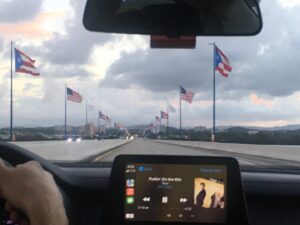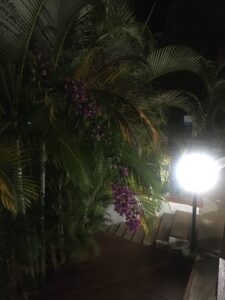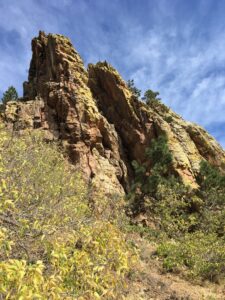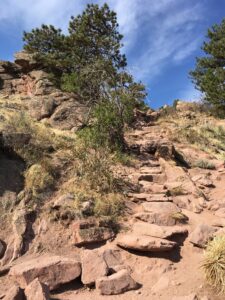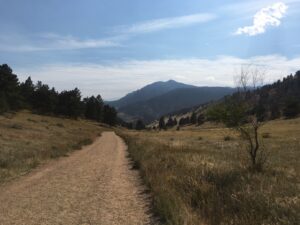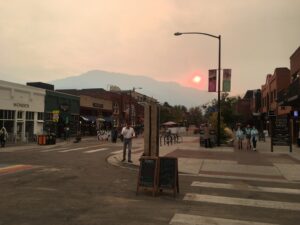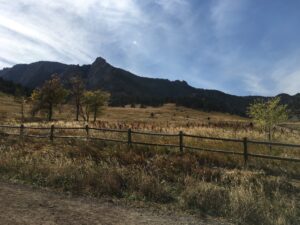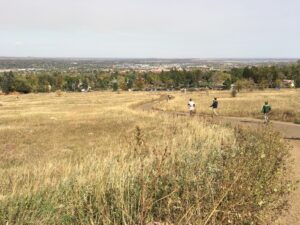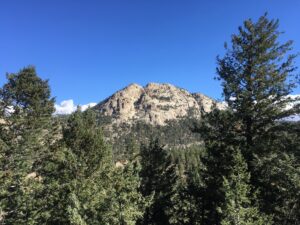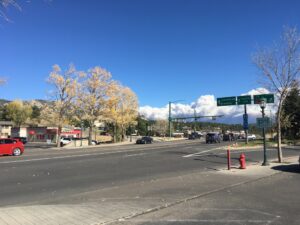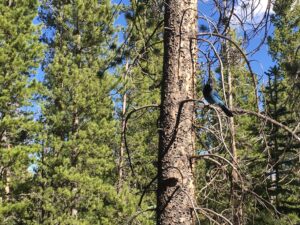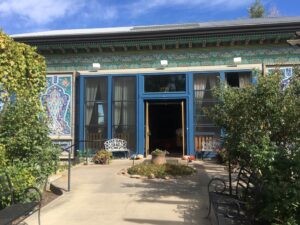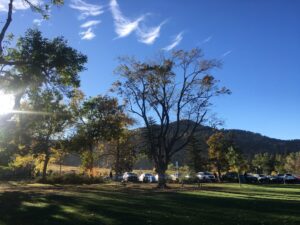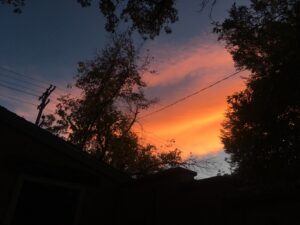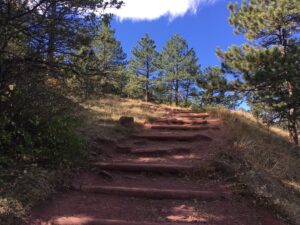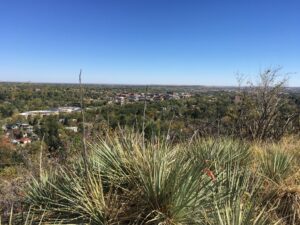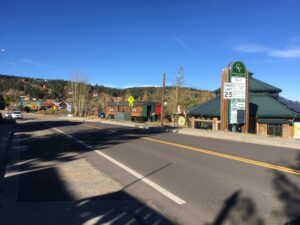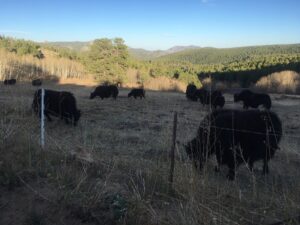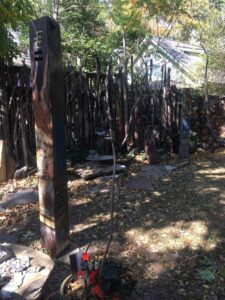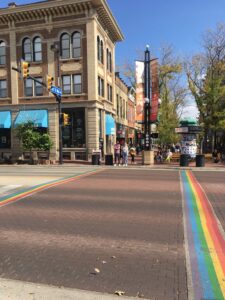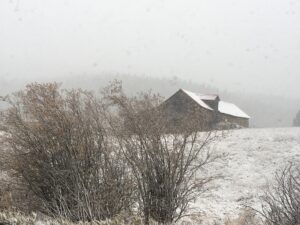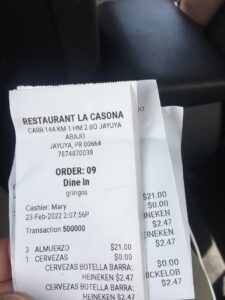
Our second day (well, first full day in Puerto Rico), involved a well-deserved slow morning after the long travel day yesterday. We were also finally able to fully enjoy the magnificently gorgeous views from our AirBnB in the daytime: lush, green foliage; brightly colored flowers of purples, oranges, and reds; heavily forested mountains dotted with casas pequeñas; misty skies shrouding rounded peaks. Indeed, the name of our casa de AirBnB is Monte Niebla or Foggy Mountain. (I’m no expert, but it might just be possible to translate more poetically to Misty Mountain, but I’m not the editor over at Collins.)
The air also felt heavy with dew, perfumed by the aromas of dense greenery and flamboyant flowers, but the temperature was manageably cool (warm?) in the mid-60s, while roosters across the land sang their boisterously energetic songs, and I immediately fell in love with everything around me.
During the morning, I was also able to have a lovely Facetime chat with my parents as my dad regaled me with stories of his travels to Puerto Rico during his Navy days in the 1960s while I showed my mom some of the flowers and trees that surrounded us. (She just loves flowers!)
It was soon time to get our day started, and the top order was to stock our pantry, as we only had some
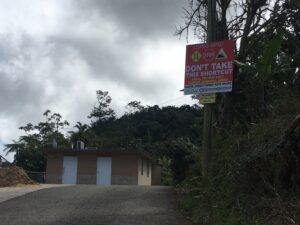
substandard Lipton’s green tea at our disposal. So we made our way down to a panadería down the street. Panadería translates directly as bakery, but the locals seem to use the word to refer to bakeries that are also mini food stores (tiendas de la comida?) that are slightly smaller than supermercados. But they will have your basic food supplies (but not in great variety) in addition to some delectably tasteful baked goods, so we stocked up on coffee (café), bread (pan), juices (jugos), and we found this lovely little tin of sardines in salsa and a bag of Doritos flavored with sour cream and onion, apparently.
Following shopping, we decided to make our way into Jayuya itself to have lunch. As we navigated our way there, we came across a sign—entirely in English—warning us that if we’re using GPS to not use the road that Google was directing us to take, since it was narrow and steep. We at first heeded the advice only to discover that that really was the only road to take to get into town. So, we braved it anyway, only to realize it was the exact same road we took (in pitch darkness) to get up the mountain to our casa yesterday night! Suddenly, the warning sign didn’t seem too imposing, and while there were sections of the road where the guard rails didn’t exactly seem very sturdy, it was all actually fine. (But, as I said yesterday, the less bravehearted might not necessarily be so keen.) Sometimes we were worried by the rain that seems to come and go in frantic bursts that last minutes, so we occasionally found ourselves pulling over for a bit just to be a little extra safe.
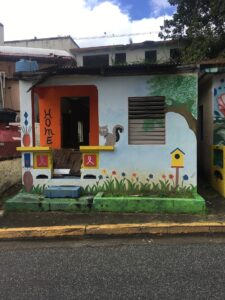
In town, we found un restaurante called La Casona, which translates roughly to large house or mansion. While we got to practice some more Spanish (“Una mesa para tres, por favor,”) there was nothing very glamorous about the place as its name suggested, as the food left much to be desired—the entire menu was just standard, fried bar food (las comidas fritas). Hilariously, however, when we got our check (nuestra cuenta), we saw on the receipt that our table was labeled gringos. A quick Google search seemed to suggest that the word isn’t exactly meant offensively in Puerto Rico as it might be in the states, but we all really didn’t care regardless and had a lovely little laugh about it. (Plus, I do think we need to lighten up about a few things in regards to language, and this is coming from a dyed-in-the-wool, bleeding heart progressive.)
Something else we discovered about using Google to find whatever we needed is that the search results didn’t necessarily seem to be entirely accurate. La Casona with its lackluster food might’ve had nearly 500 Google reviews averaging at 4.5 stars (maybe the drinks are better?), but the posted hours of operation might not exactly be correct. As we tried to search for any little coffee shop following lunch (Aaron and I had tolerated the Lipton’s green tea earlier, but poor Amy hadn’t had any caffeine), coffee shops that were supposed to be open either weren’t (maybe it was during siesta?) or no longer existed. However, it was quite enjoyable trying to find anything as we admired the town’s murals—colorful paintings of cats and roosters brightening buildings all across town.
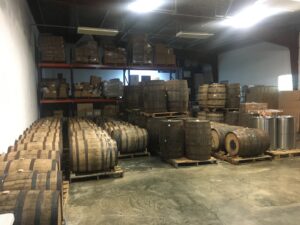
Our next stop was La Destilería Craft Spirits, una destilería de ron (a rum distillery) located on the northern side of Jayuya. When we entered, the employee—who was terribly friendly—seemed surprised that we found the place at all, asking somewhat confused, “Did you find us on Google?” We were delighted, however, when we were treated to a tour of their operations, learning about how their aging barrels are purchased from Jack Daniels (apparently Jack Daniels only uses the barrels for a year and then gets rid of them), finding out how rum and moonshine is made, and lastly treating ourselves to a tasting of various varieties of their distilled spirits. (Obviously, we ended up purchasing two bottles to take home.)
Our last stop before returning home was to an Econo, a supermercado chain, where we picked up some steak and potatoes to grill back at Monte Niebla. You can also buy booze in supermercados, but they also have proper liquor stores as well.
And so, after enjoying some fine grilled foods, bubbly wine, and bebidas de ron con jugo y lima, our first full day was under our cinturones. Looking onwards, our next day would prove to be filled with thrills of the likes I’ve never experienced…
Spanish lesson for the day:
- If you’re driving in Puerto Rico, you’ll want to learn these basics: póxima salida (next exit); izquierda (left); derecha (right); pare (stop); ceda (yield); solo (only); carril (lane); cerrado (closed); abierto (open); este, oeste, norte, sur (east, west, north, south); calle (street); carretera (highway); and trabajar (means to work, but if you see it conjugated in a sign, there’s probably some kind of road work ahead).
- I wrote about the verb queren (to want) in my last post. But if you’re at a restaurant, you may want to use the slightly more friendly version of queren, the conditional conjugation: quisiera which translates to, “I would like,” or querríamos which translates to, “We would like.”
- Finally, many locals will greet you with, “Buenos dias,” “Buenas tardes,” “Beunas noches,” and so on, but you may also simply respond or greet someone with just, “Buenas,” and that’s sufficient enough to be friendly to say hello. And, in general, be friendly and say hello.
Travel tips, day two:
- While we seem to be generally okay in our compact car, some of the roads within the center of the island are so steep and windy (or under construction and exist as washed out gravel), that a Jeep would’ve been useful. However, if you’re staying to the northern, more populated area of the island, any style car will probably do.
- While you’re driving, be on the constant lookout for dogs, cats, roosters, chickens, cows, and horses. The domesticated animals here seem to be very used to cars slowing down for them and—in some cases—driving around them entirely as they lounge in the middle of the road.
- Lastly, intersections aren’t necessarily commonly controlled by stop signs or traffic lights, and the process to navigate through them is a shared responsibility of being kind to one another. How novel.

